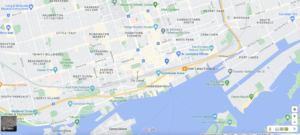Toronto, Ontario
November 3, 2022 By: Allegra Solecki
Location: {43.646183,-79.3760337}

I currently live in the financial district of downtown Toronto, Ontario. The financial district is home to several bank headquarters, legal and accounting services, as well as stockbrokers. Thrown in the mix are high rise condos, one of which I’m fortunate enough to live in. Since this a relatively small area of Toronto, I will focus on the environmental history of the city itself. The name Toronto is derived from the Mohawk word tkaranto, which translates to “where there are trees standing in the water”. As I will explain shortly, Indigenous groups were the first to settle in Toronto, and several cities eventually amalgamated to form Toronto.
Human settlement in Toronto can be traced back some 12,500 years ago after the end of the Ice Age, but most events have occurred since the 1600’s. After the Laurentide Ice Sheet melted from the area that we now know as Toronto, Indigenous groups began to inhabit the area. The largest groups to settle, both seasonally and permanently were the Mississauga and the Anishinaabe people, and eventually the Haudenosaunee years later. Because of Toronto’s geography (the south is located on the shore of Lake Ontario, and the Don and Humber Rivers are on either side of the city), the area was a resource rich place to settle, at least in the warmer months. In the summer, Indigenous groups would gather around the rivers and creeks to fish and hunt caribou. These areas, including what is now considered Toronto Islands, were also spiritual places where loved ones were buried. Humber River proved to be especially important as it provided a gateway to Georgian Bay and the upper Great Lakes via Lake Ontario, even year-round. This was crucial for fur trading, where French fur trading posts were set up.
When Europeans arrived in the Toronto area, they brought disease and colonialism with them. Slowly, indigenous groups began to migrate out of the area. After the British Conquest of 1759, the first governor of Upper Canada began developing the area of Toronto, building parliaments and government buildings. By 1830, the colonial government had proposed several treaties with the Indigenous groups to acquire their land. The most significant was Treaty 13, more often referred to as the Toronto Purchase. In this treaty, the Mississauga’s surrendered their land to the crown, an area that covers most of the west and north sides of modern Toronto. The areas once rich in resources were being destroyed by settler poaching, sawmill development and colonial agriculture. The Don and Humber rivers and the lakes became polluted with runoff from agricultural and industrial activities, harming wildlife and leaving little to no resources for Indigenous groups who depended on these areas.
Following the Toronto Purchase, the surrounding areas began to see an increase in British Immigrants, and that’s when urban development really took off. Toronto was incorporated with a population of 9,000 in 1834, and William Lyon Mackenzie became the first mayor. Just a few years later, the city was going full force ahead and had a sewer system on main streets, a railway connecting to Montreal, steamboats launching from the harbour, factories, plants & foundries, and banks and insurance companies began flocking to the new city. By the mid 1900s, construction had begun on the subway system, Billy Bishop City Centre and Toronto Pearson airports existed (both under different names then), and the famous Union Station was opened to the public.
While it may be hard to imagine the concrete jungle of Toronto as home to wildlife, there are many diverse species here today. This is partially because the green spaces in Toronto are almost all connected through rivers, creeks and ravines, so the animals can travel safely through these corridors without needing to be in the streets. However, it is not uncommon to spot wildlife such as racoons, foxes, coyotes, skunks and squirrels in developed areas of the city. Toronto’s ravines are critical to the city’s health, but are currently threatened by invasive plant species such as phragmites, garlic mustard and dog strangling vine. Litter from humans is also a huge problem.
Luckily, Toronto is modernizing itself when it comes to environmental issues. With regards to its ravines, City Council adopted the Ravine Strategy Implementation Plan to clean up and protect the entire ravine system. In 2019, the city launched a massive watershed project to clean up the Don River, and protect the shorelines. Toronto also piloted the Blue Bin Program, aimed at decreasing waste and increasing recycling by shifting the responsibly of package recycling on the producers.
Toronto’s rich diversity with rivers, ravines, Lake Ontario and all its wildlife was once a thriving area when early settlers arrived in the area. With its quick urbanization, its population exploded and the city’s green spaces shrunk and were polluted, but with the new steward projects in motion, hopefully Toronto is on the right track to regain what it once had.
References:
https://en.wikipedia.org/wiki/History_of_Toronto#:~:text=The%20first%20human%20settlers%20arrived,glaciers%20retreated%20from%20the%20area.
https://www.ontario.ca/page/indigenous-culture-and-history-along-transcanada-trail
https://torontopubliclibrary.typepad.com/local-history-genealogy/2018/06/remembering-the-toronto-purchase-and-its-settlement-june-8-snapshots-in-history.html
https://www-jstor-org.ezproxy.tru.ca/stable/pdf/43560271.pdf?refreqid=excelsior%3Ad433b027ae651f93410259bf3d1b38bc&ab_segments=0%2Fbasic_search_gsv2%2Fcontrol&origin=&acceptTC=1
https://www.toronto.ca/community-people/animals-pets/wildlife-in-the-city/
https://www.thecanadianencyclopedia.ca/en/article/toronto
https://www.theglobeandmail.com/canada/article-torontos-ravines-are-in-a-critical-state-threatened-by-invasive/
Hi
So nice to have a review of my old home town TO
I now live in a coastal community in BC so quite a change
I lived in Georgetown Ontario and I concur with the abundance of wild life
I frequented the areas of the Credit Valley Conservation Projects – Interestingly they returned the habit back to its natural state at the Waterfalls Playground – Spent many summers there.